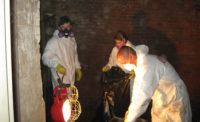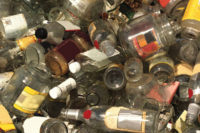Sewage Cleanup: It’s Not Your Average Job




There’s the containment aspect. The safety aspect. The technical aspect. And that’s not even taking into consideration the intangibles.
There’s a lot that goes into a typical sewage cleanup job, from containing the affected area so that there’s no cross contamination, to protecting yourself from exposure to fecal matter and blood borne pathogens, to dealing with adjusters who just want to pay you for a Category 1 or 2 loss when you’re unquestionably dealing with a Category 3 loss, (for more on this, see Dave Dybdahl’s story on Pg. 22) to knowing where to dump any sewage you’ve extracted.
And, of course, in between all of that there’s also the task of knowing and following the IICRC S500 Standard for proper protocol in restoring the property to a pre-loss condition.
Bill Weber, Regional Manager and VP of Anderson Group International, knows a thing or two about cleaning up sewage. He works two to three sewage jobs per week in California’s Bay Area, cleaning both commercial and residential properties.
“The difference between a regular job and a sewage job involves containment skills,” he says. “The first goal is not to cross contaminate areas that weren’t originally impacted. So as a result, we’re putting down floor protection when we get to these areas so in the transit, the back-and-fourth in the building, we’re not now contaminating areas that weren’t contaminated originally. Then we’ll set up containments around the area, usually plastic around the doorways or entranceways.”
Commercial jobs are a little more sensitive than residential jobs, Weber says, in terms of what type of containment is used. In residential jobs clear plastic is ideal, but black or darkened plastic is best for commercial jobs so that customers or bystanders can’t see or become alarmed by what is being done in the area.
Containment, however, is just the start of a sewage job.
Staying Safe
“We see plumbers all the time who are in and around these sewage situations and all they have on is their jeans and T-shirt,” Weber says. “They don’t have any PPE on. Plumbers look at us and laugh sometimes with all the protective gear we wear, because they’ve been doing it for 35 years and never had an infection or anything like that.”
It’s a risk that Weber prefers not to take – and with a quick search on the CDC’s website for potential health hazards after coming into contact with fecal matter, it’s easy to see why. That’s why respiratory protection and skin protection are a must for Weber.
“We want to keep that sewage off the skin, off any cuts, off any kind of mucus membrane,” he says. “We want to protect the eyes, the nose, the ears. You cannot do a sewage job without the proper PPE. For me, no matter how healthy the guy is… I have a responsibility toward the employee to make sure he’s dressed appropriately for the situation. Will the full face (respirator) take care of that? The full face, protective coveralls and gloves? Absolutely.”
In addition to a full-face respirator and disposable coveralls, Weber advises wearing tear-resistant nitrile gloves with gauntlet or heavy-duty gloves and duct-taping the gap between the coveralls and the gloves. He says rubber boots should be worn to protect the feet and that respirator wipes, an eye wash station, sanitizer wipes and an extra change of clothes should all be handy as well.
Last but not least, having an exposure control plan that includes blood borne pathogen training for employees is a must, Weber says.
Cleaning and Decontamination
“Typically, you extract and you assess what needs to be done from there,” Weber says.
Following extraction, the next course of action should be determined by the IICRC S500 Standard, which states that anything porous (i.e., drywall, particle board) should be disposed of and removed, anything semi-porous (i.e., plywood subfloor) should be analyzed on an item-by-item basis and that anything non-porous (i.e., metal filing cabinet) can be cleaned and sanitized.
Cleaning and sanitizing practices vary between professional. Weber administers a low-volume, high-heat steam cleaning method, where the pressure washing is able to dislodge contaminants in hard-to-reach locations and the 212º F water temperature is hot enough to kill bacteria. Others, however, may hand clean using broad range disinfectant chemicals. An ultrasonic cleaner that uses a disinfectant cleaning chemical is also suitable for restoring sewage-soaked items.
A consideration following the job that must be kept in mind is where to dump any extracted sewage after the job is done. Just think – if the sewer is backed up, where can it go? That’s where a portable reservoir comes in handy.
You could make the case that getting into sewage cleanup is a lot like getting into bio-recovery work – it’s not for everyone. Weber has worked with people so grossed out by the scene that they’ve thrown up into their full-face respirators.
So is sewage cleanup right for you?
Looking for a reprint of this article?
From high-res PDFs to custom plaques, order your copy today!











